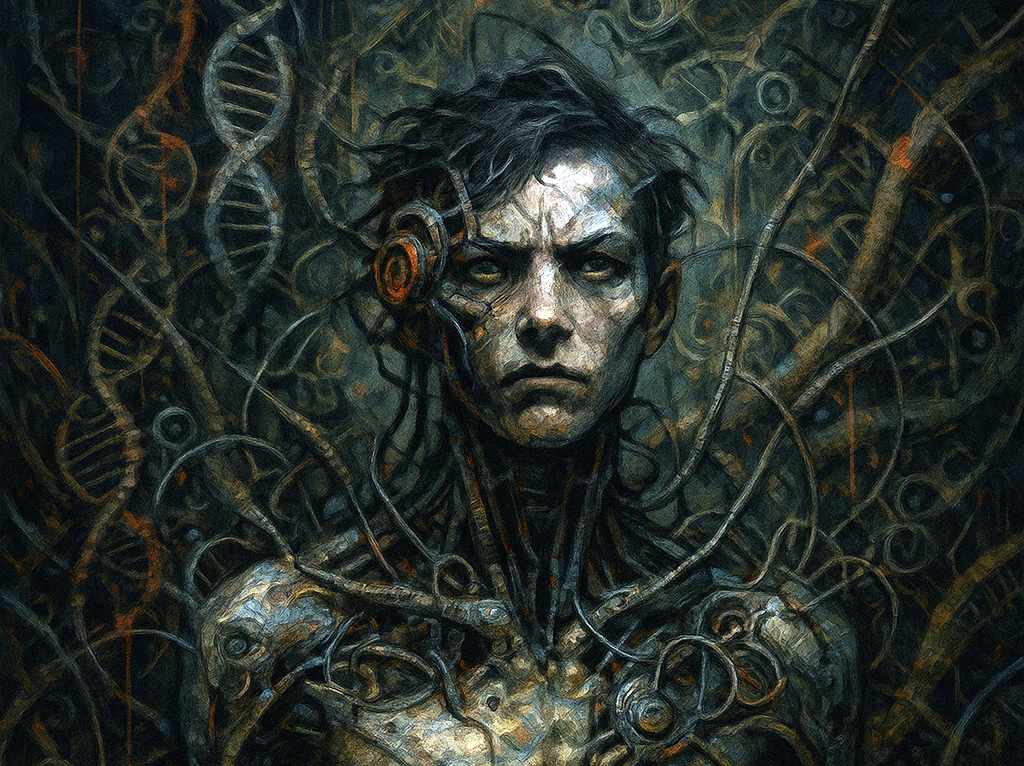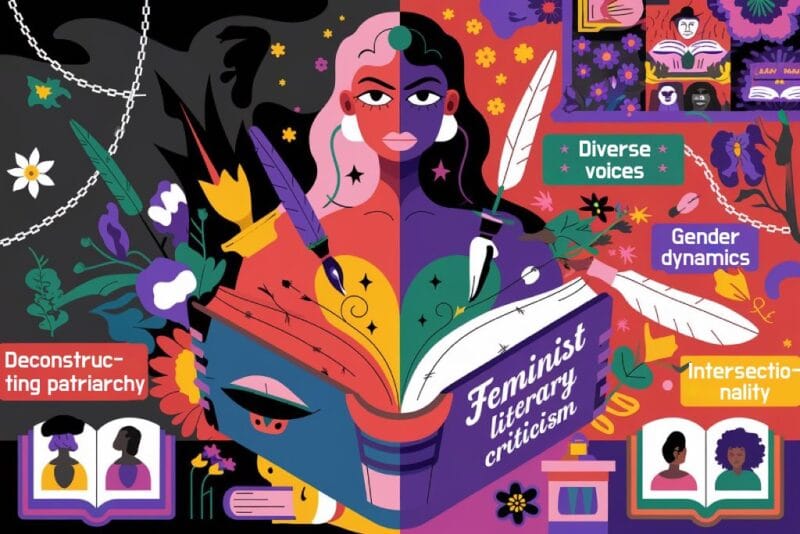In the shadow of synthetic embryos, gene-editing breakthroughs, and citizen biologists assembling CRISPR kits in their kitchens, fiction is already one step ahead. Biopunk, a literary subgenre once orbiting the margins of science fiction, has evolved into a vital narrative form concerned less with the future of technology than with the future of the body. Where cyberpunk explored the digitization of selfhood, biopunk shifts to the cellular level to explore how power alters the body, reconfigures autonomy, and redefines what it means to be human.
Biopunk is defined by its focus on genetic engineering and biohacking. It gains strength from the way it alters narrative form to reflect the body’s instability and the ethical questions emerging from its modification. The stories often break traditional structure, challenge assumptions about identity, and expose the pressures exerted on the body by systems of control. Reading biopunk means confronting a literature that treats biology as something programmable instead of inherited. It is here, within gene-sequencing plots and unstable narrative structures, that the human story is being rewritten.
The Literary Evolution of Biopunk
Biopunk emerged from the narrative foundations of cyberpunk, but it redirects attention from digital networks to biological systems. While cyberpunk centered on data, virtual consciousness, and machine interfaces, biopunk turns toward cells, organs, and genetic code. It replaces cyberspace with flesh, circuitry with tissue. In cyberpunk, control flows through networks of information and digital surveillance. Biopunk reconfigures that dynamic by shifting the locus of power to the body itself. Code gives way to genome, and hacking evolves into biohacking. The body becomes the primary site of intervention and struggle.
Foundational Works
Where William Gibson’s Neuromancer (1984) imagined minds leaving the body to enter cyberspace, biopunk rejects that separation. The flesh remains central, exposed to manipulation, subject to control, and never beyond reach but easily owned. This focus grounds the genre’s earliest influential works: Greg Bear’s Blood Music (1985) imagines intelligent cells evolving within a man’s body, making him both host and frontier; Bruce Sterling’s Schismatrix (1985) and Paul Di Filippo’s Ribofunk (1996) further explored these narrative possibilities.
The genre reached literary maturity with Paolo Bacigalupi’s The Windup Girl (2009). The novel is set in a future Bangkok suffering from environmental catastrophe, where huge food corporations control the world through seed patents. It blends ecological disaster with biopolitical dread, establishing biopunk’s defining concerns: climate catastrophe, corporate control over biology, and the dehumanization of genetically engineered people.
Defining Features of Biopunk
Biopunk fiction questions both the ethics and the aesthetics of life as something subject to modification. Common features include:
- Genetically engineered humans, hybrids, or species
- Degrading ecosystems and resource monopolies
- Rogue scientists, underground labs, and biohackers
- Clinical language and procedural narratives
- An omnipresent anxiety around contamination, control, and bodily sovereignty
The Body as Site of Power
To understand biopunk’s narrative focus, one must begin with Michel Foucault’s notion of biopolitics: the way modern institutions regulate life processes, from birth to death. Biopunk extrapolates this logic to its extreme. Here, the body is no longer sacred—it is data, property, collateral. It is not merely represented in fiction but otherwise contested, commodified, and undone. In these narratives, the body becomes a terrain of conflict between individual agency and institutional authority. It is the site where genetics, economics, and ideology stand in opposition.
Fictional Explorations of Bio-Surveillance
In The Windup Girl, bio-surveillance is both infrastructural and intimate. Patents extend not just to seeds but to species. Genetic modification is regulated by corporations that hoard biodiversity for profit. The novel’s titular character—Emiko, a “windup” human designed for obedience—embodies the genre’s obsession with programmed flesh. In Daniel Suarez’s Change Agent (2017), the stakes are even more sinister. Criminals reengineer their DNA to assume new identities, rendering biometrics obsolete. Identity dissolves under biotech’s shadow. The protagonist becomes a case study in the involuntary transformation of a man literally overwritten at the molecular level.
The Illusion of Autonomy
Biopunk reveals the instability of bodily autonomy in worlds where the body is no longer strictly personal; it is a resource subject to surveillance, manipulation, and ownership. Autonomy is a fragile illusion. The systemic reach of biocapitalism and regulatory control compromise this right. What emerges is a vision of subjectivity that is contingent on systems that treat the body as a programmable asset. Biopunk asks whether the self can exist when its biological foundation has already been pre-programmed, when the line between person and product has been quietly, yet fundamentally, crossed.
Resistance Narratives in Biopunk: Biohackers and Genetic Dissent
Who Resists? Biopunk’s Antiheroes
Biopunk retains the punk lineage of defiance, but its rebels are not cyber-drifters but are geneticists in exile, lab-grown runaways, dissidents with spliced chromosomes. They operate in back-alley clinics or submerged labs, forging resistance through subversion of form: editing genes as one edits text, rewriting bodies against the grain of control. These figures are often morally ambiguous, their actions desperate rather than heroic. But in their refusal to accept imposed biology, they reassert the political potential of the body.
Punk Spirit in the Genetic Age
The punk spirit in biopunk is constructed through sabotage, not grand gestures. Resistance emerges through small, precise acts that disrupt systems from within. The genre’s antiheroes often challenge the aesthetics of purity, perfection, and optimization. They inject disorder into a world built on control. They splice, corrupt, or hybridize, unraveling the illusion of engineered inevitability. Their fight is not just for freedom but for the right to be unreadable, untracked, and unowned.
DIY Biology and Real-World Parallels
This literary rebellion is not entirely fictional. Real-world biohackers build open-source gene-editing tools, inject themselves with experimental therapies, and question the centralization of medical knowledge. The ethos of biopunk resonates with these movements: distrust of authority, decentralization of science, and a reimagining of who gets to design life. Biopunk fiction mirrors these anxieties and ambitions by embedding them in narratives that examine not just what can be done to the body but what ought to be.
Literary Themes in Biopunk
Biopunk confronts the reader with the uncomfortable proximity between technological possibility and ethical vacuity. The genre seldom offers answers but instead poses scenarios. If we can eradicate disease through embryo selection, should we? If we can enhance memory, empathy, or intelligence through splicing, who decides what’s desirable? The literature wrestles with these dilemmas not in the abstract, but through characters who live with the consequences of engineered existence.
Human, Posthuman, or Other?
The central philosophical tension in biopunk is not between human and machine, but between human and modified human. In Jeff VanderMeer’s Borne (2017), the post-apocalyptic landscape is populated by bioforms as living experiments whose status oscillates between companion and commodity. The creature Borne, who may be animal, child, or failed experiment, destabilizes every taxonomy. In Never Let Me Go (2005), Kazuo Ishiguro offers a subtler horror. The clones, raised for organ donation, are painfully human and express human traits of being gentle, reflective, and creative. Their tragedy lies in their complete acceptance of disposability, a narrative of muted resistance that critiques the ethics of unspoken compliance.
The Question of Dignity
What does dignity mean when life is constructed, when one’s purpose is encoded before birth? Biopunk narratives continually circle this question. Some characters rebel, others resign, but all grapple with the dissonance between internal identity and externally imposed function. The genre bypasses simple ethics, confronting the problematic essence of dignity in manufactured biology..
Narrative Structure and Style
Biopunk’s Narrative Structure
Biopunk frequently abandons traditional linearity in favor of forms that mimic instability and recursive discontinuity. The architecture of these narratives often mirrors the disordered systems they depict, such as gene sequences out of alignment, institutions failing to cooperate, or identities split across ontologies. Stories loop, splinter, or fail to resolve not out of experimental excess but to reflect a world where cohesion has been chemically destabilized.
This narrative approach is not simply experimental but reflects structural realism. The fiction bends to the pressure of its content: chronology mutates and perspective shifts; cause and effect begin to blur under the influence of engineered environments and unreliable bodies. In some cases, the structure feels closer to a lab notebook or clinical log than a conventional plot arc, as if the story has been subjected to splicing.
Like strands of DNA, the narrative often consists of multiple threads that are converging, overlapping, or recombining without clear hierarchy. Different voices, temporalities, and species perspectives are layered in a manner that avoids synthesis. These texts rarely move toward final alignment; instead, they generate variations by layering contradictory impulses without seeking coherence.
Language and Imagery
The language of biopunk tends to carry both technical precision and symbolic overload. It borrows heavily from the vocabularies of medicine, molecular biology, and biochemistry, often stripping the body of its human familiarity. Descriptions that once evoked emotion now produce discomfort: a heartbeat described as a data rhythm, blood analyzed as viral load, organs treated as replaceable modules. These lexical choices render the body foreign even to the subject.
At the same time, biopunk traffics in metaphor with the use of mutation as evolution, contamination as resistance, or splicing as narrative method. Flesh becomes a semiotic battleground. The genre blends the clinical and the grotesque using imagery that forfeits binaries: flesh and machine, purity and disease, repair and mutation. Characters are frequently described in terms of their molecular breakdowns, their visible grafts, or the deterioration written into their biology.
This fusion of language and image often strains reader comfort. The prose abandons elegance in favor of exposure. It does not simply explain biotechnology but further implicates the reader in it.
Style as Reflection of Subject
Biopunk reprograms not only the body but also the sentence. The genre’s stylistic tendencies reflect its conceptual focus: sterile prose mirrors dehumanization; excessive description mirrors biological excess; even the rhythm of the sentences often feels coded by being algorithmic or breathless, depending on the scene. The aesthetic is not a performance layered over content but a system within a system, altered from within by the forces it attempts to narrate.
Biopunk’s style serves as more than an atmospheric tool; it expresses the genre’s underlying philosophical tensions. Prose may oscillate between flat, affectless description and bursts of sensory overload, simulating the disorientation of existing in a body under external control. Syntax fragments or expands to reflect cognitive instability, chemical interference, or imposed biological constraints. In some narratives, the text appears infected, with terminologies repeating obsessively or neologisms proliferating with the logic of a viral mutation.
Why Biopunk Matters: Literary and Cultural Relevance Today
As synthetic embryos advance toward viability and gene-editing techniques like CRISPR become more accessible outside institutional labs, the boundary between speculative fiction and scientific reality begins to dissolve. Biopunk no longer speculates from a distance; it participates in a conversation already underway, one where the ethical, legal, and existential consequences of biological engineering unfold not in imagined futures, but in research facilities, policy debates, and DIY biohacking communities.
Within this domain, biopunk literature functions as imaginative foresight, beyond simple prophecy. These narratives create space for ethical rehearsal. They dramatize entanglements; they do not predict outcomes. The stories ask what happens when bodies are modified, when personhood is revised by gene sequence, and when identity is dictated by programmable flesh. They do not warn with alarms. They pose the essential question: What does this change mean for how we understand life, agency, and relation? This function of literature as speculative ethics places biopunk at the center of a critical literary task: it investigates what should be done with the powers we already possess. The investigation is ethical, not predictive.
Reframing the Human Story
Biopunk literature participates in the oldest literary tradition: the question of what it means to be human. But in these works, that question is no longer philosophical. It is medical, legal, social, and deeply material. It is a story written in proteins and rewritten in code. It is not just about the self but about who gets to define the self.
Biopunk challenges abstract or universal definitions of selfhood by anchoring identity in biological and institutional realities. In biopunk literature, DNA functions not as a symbolic device but as a literal medium through which identity is constructed, categorized, and regulated. The genome becomes a form of authorship, determining the boundaries of personhood through technical processes such as sequencing, editing, and deletion.
The self in these narratives often emerges through interactions with legal systems, scientific institutions, and corporate databases, rather than through memory, introspection, or cultural inheritance. This reconfiguration enables biopunk to examine how individuals are rendered visible, classified, or constrained within systems that treat biology as both information and asset.
The Role of Biopunk in Contemporary Fiction
To read biopunk today is to encounter a mode of storytelling that pushes fiction into direct engagement with the ethical, philosophical, and material conditions of contemporary life. Unlike speculative genres that trade primarily in imaginative possibility, biopunk concentrates on the limits of permissibility—on what should be done with the tools already available. Its questions are not framed in a distant future but in a present where the line between the experimental and the operational has already begun to dissolve.
Biopunk contributes to literary fiction not only by addressing contemporary anxieties surrounding synthetic biology and the commodification of life but also by expanding the technical and formal range of the novel. It creates a space for new modes of narrative experimentation that reflect the thematic pressure of the genre. Traditional coherence gives way to modular scenes, overlapping chronologies, and recursive character developments that never fully stabilize. These strategies are not ornamental; they serve as extensions of the genre’s central concerns, making the form of the story inseparable from its content.
The stylistic features of biopunk respond directly to its subject matter. Sentences are often structured in a way that feels chemically precise or clinically detached, while shifts in tone or register may suggest the intrusion of nonhuman or system-level perspectives. Syntax may break down under the pressure of narrative stress, just as character consciousness dissolves under the influence of genetic engineering or pharmacological conditioning. These disruptions are deliberate. They foreground the porousness of narrative and the permeability of identity in a world where bodies are increasingly mediated, monitored, and modified.
Fiction as a Mirror of Systemic Instability
What biopunk offers, then, is not an escape from contemporary dilemmas but a means of articulating them through fiction. It repositions the novel as a diagnostic tool capable not only of exploring cultural anxiety but of reflecting its structures. Biopunk expands the reach of literary form by absorbing uncertainty into its style and by making technical disorientation function as a kind of narrative realism. Instead of upholding the conventions of plot or character development, it chooses to model instability, disjuncture, and adversity as essential narrative principles.
This orientation does not sever biopunk from literary tradition. It places it in continuity with earlier modes of formal innovation, particularly those that emerged in response to social and technological upheaval. Just as modernist fiction responded to the mechanization of labor and the trauma of industrial warfare with experiments in stream of consciousness and disjointed chronology, biopunk responds to bioinformatics, synthetic biology, and genetic control with a reconfiguration of narrative logic.
Biopunk fiction functions as more than a speculative lens on emergent science; it compels a re-evaluation of literary aesthetics. It redefines what a narrative can accommodate and how language can reflect states of embodied uncertainty. The genre’s critical role resides in its capacity to delineate the points of tension where technology, biology, and subjectivity meet—those junctures where literature must extend its forms to accommodate the realities it seeks to comprehend.
Further Reading
Just What is Biopunk? by Caitlin Hobbs, Book Riot
Why Don’t We Like Biopunk? By Olga Ryzhychenko, Medium
The Utopian Potential of Biopunk by larsschmeink.de
Any recommendations for “bio-tech” science fiction books or media? I’m looking for inspiration on Reddit




